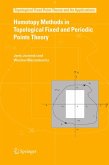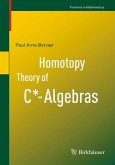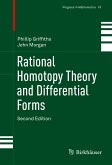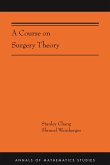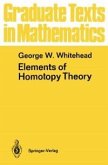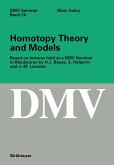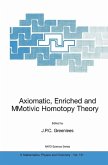This is a book in pure mathematics dealing with homotopy theory, one of the main branches of algebraic topology. The principal topics are as follows:
. Basic homotopy; . H-spaces and co-H-spaces; . Fibrations and cofibrations; . Exact sequences of homotopy sets, actions, and coactions; . Homotopy pushouts and pullbacks; . Classical theorems, including those of Serre, Hurewicz, Blakers-Massey, and Whitehead; . Homotopy sets; . Homotopy and homology decompositions of spaces and maps; and . Obstruction theory.
The underlying theme of the entire book is the Eckmann-Hilton duality theory. This approach provides a unifying motif, clarifies many concepts, and reduces the amount of repetitious material. The subject matter is treated carefully with attention to detail, motivation is given for many results, there are several illustrations, and there are a large number of exercises of varying degrees of difficulty.
It is assumed that the reader has had some exposure to the rudiments of homology theory and fundamental group theory; these topics are discussed in the appendices. The book can be used as a text for the second semester of an algebraic topology course. The intended audience of this book is advanced undergraduate or graduate students. The book could also be used by anyone with a little background in topology who wishes to learn some homotopy theory.
. Basic homotopy; . H-spaces and co-H-spaces; . Fibrations and cofibrations; . Exact sequences of homotopy sets, actions, and coactions; . Homotopy pushouts and pullbacks; . Classical theorems, including those of Serre, Hurewicz, Blakers-Massey, and Whitehead; . Homotopy sets; . Homotopy and homology decompositions of spaces and maps; and . Obstruction theory.
The underlying theme of the entire book is the Eckmann-Hilton duality theory. This approach provides a unifying motif, clarifies many concepts, and reduces the amount of repetitious material. The subject matter is treated carefully with attention to detail, motivation is given for many results, there are several illustrations, and there are a large number of exercises of varying degrees of difficulty.
It is assumed that the reader has had some exposure to the rudiments of homology theory and fundamental group theory; these topics are discussed in the appendices. The book can be used as a text for the second semester of an algebraic topology course. The intended audience of this book is advanced undergraduate or graduate students. The book could also be used by anyone with a little background in topology who wishes to learn some homotopy theory.
Dieser Download kann aus rechtlichen Gründen nur mit Rechnungsadresse in A, B, BG, CY, CZ, D, DK, EW, E, FIN, F, GR, HR, H, IRL, I, LT, L, LR, M, NL, PL, P, R, S, SLO, SK ausgeliefert werden.
From the reviews:
"Homotopy theory constitutes a branch of algebraic topology, a subject whose modus operandi, enshrined in its very name, consists of attaching algebraic objects to topological spaces for the sake of reducing topological problems to simpler algebraic ones. ... Summing Up: Recommended. Upper-division undergraduates and above." (D. V. Feldman, Choice, Vol. 49 (7), March, 2012)
"The book under review is an excellent addition to the beginning graduate level offerings in homotopy theory. A distinguishing feature is a thematic focus on Eckmann-Hilton duality. ... this book offers an attractive option for a course or self-study, fitting a niche between the introductory texts of Munkres, Massey and Thatcher and the comprehensive treatments of homotopy theory by Spanier and Whitehead." (Samuel B. Smith, Mathematical Reviews, Issue 2012 f)
"Arkowitz' Introduction to Homotopy Theory is presumably aimed at an audience of graduate students who have already been exposed to the basics of algebraic topology ... . Introduction to Homotopy Theory is presented in nine chapters, taking the reader from 'basic homotopy' to obstruction theory with a lot of marvelous material in between ... . Arkowitz' book is a valuable text and promises to figure prominently in the education of many young topologists." (Michael Berg, The Mathematical Association of America, October, 2011)
"Homotopy theory constitutes a branch of algebraic topology, a subject whose modus operandi, enshrined in its very name, consists of attaching algebraic objects to topological spaces for the sake of reducing topological problems to simpler algebraic ones. ... Summing Up: Recommended. Upper-division undergraduates and above." (D. V. Feldman, Choice, Vol. 49 (7), March, 2012)
"The book under review is an excellent addition to the beginning graduate level offerings in homotopy theory. A distinguishing feature is a thematic focus on Eckmann-Hilton duality. ... this book offers an attractive option for a course or self-study, fitting a niche between the introductory texts of Munkres, Massey and Thatcher and the comprehensive treatments of homotopy theory by Spanier and Whitehead." (Samuel B. Smith, Mathematical Reviews, Issue 2012 f)
"Arkowitz' Introduction to Homotopy Theory is presumably aimed at an audience of graduate students who have already been exposed to the basics of algebraic topology ... . Introduction to Homotopy Theory is presented in nine chapters, taking the reader from 'basic homotopy' to obstruction theory with a lot of marvelous material in between ... . Arkowitz' book is a valuable text and promises to figure prominently in the education of many young topologists." (Michael Berg, The Mathematical Association of America, October, 2011)



